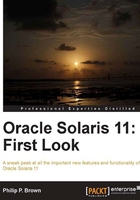
The brave new world of IPS
Solaris 11 has an all new packaging system for OS-related packages, in which the packages are primarily accessed via the pkg command. This new command handles the acquisition/downloading of OS packages, as well as local installation and removal of the files on local storage.
Legacy format packages, also known as System V Release 4 (SVR4) style packages, are still supported; pkgadd and related commands still work. This is not merely for third-party developers. Oracle itself still distributes some Solaris 11-related packages in SVR4 packages.
Even though Oracle has not stopped using SVR4 packages, the new pkg interface has some notable benefits, such as extra hooks to integrate safely with zones, and automatic use of ZFS snapshots for certain types of package upgrades. It is for this reason that Solaris 11 does not support UFS as a root filesystem. The new packaging system requires ZFS for part of its standard operations.
This chapter breaks down the concepts of the new package system into four main areas:
- An overview of package repositories
- Understanding package naming
- Understanding conceptually how packages are installed
- Practical use of the
pkgcommand
The majority of the chapter is taken up with the practical use section.